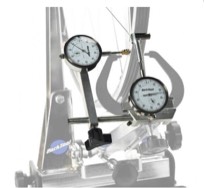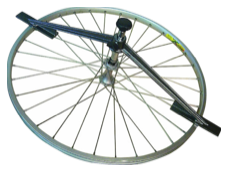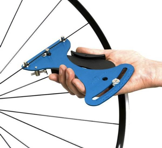What to look for in a hand built wheel
There are a number of quantifiable parameters to a finished wheel...
- Radial deviation
- Lateral deviation
- Dish
- Average spoke tension per side
- Uniformity of spoke tensions on each side
- Weight
- Strength
- Durability
- Price
- Looks
- Fashion
- Brand loyalty
- One-upmanship
- Ride "feel"

The nearest "official" specification I could find for radial trueness, BS 6102-6, is purported to allow up to 4mm of radial deviation of the rim but I can't confirm this as I don't feel like forking out £130 for the document. Achievable tolerances are very much dependant upon the quality of the rim to start with but, but by using deflection dial gauges, I can comfortably aim for a maximum deviation of 0.5mm - far smaller than anything that can be noticed through the tyre.
Lateral tolerance
BS 6102-6, is purported to allow up to 2mm of lateral deviation but by using deflection dial gauges I can achieve tolerances in the region of 0.2mm or better. Anything less than this will likely be masked by the hub bearings anyway.

Dish is the measure of where the rim sits relative to the centre line of the bicycle frame after lateral deviations have been minimised. For a front non-disc wheel this coincides with the centre line of its hub but for a rear wheel that has to accommodate a cassette it does not. Here the distance from each hub flange to the centre line of the bicycle frame is different which leads to a different spoke angle from hub to rim on each side of the wheel.
Plus or minus 1mm or more either side of the centre line is not uncommon. I dish to 0.5mm or better.
Spoke Tensions

Furthermore, it is important for the durability of the wheel that spoke tensions across each side of the wheel are as close as possible to the average tension of all the spokes per side. Manufacturing tolerances in rims mean that sometimes good spoke tension and good radial and lateral deviation become mutually exclusive targets. In such cases I favour good spoke tension and aim for each spoke to be within 5% of the average tension for its side of the wheel.
Strength
Strength is the measure of how much load the wheel can resist before collapsing. This point is reached when the bottom few spokes have been compressed so far by the load that they lose all their tension. It is for this reason that I tension spokes to near the maximum that the rim can take.
But strength is also derived from the number of spokes, their profile and the construction of the rim. The more spokes the more the load is evenly distributed to the rim. A deeper section rim can be tensioned more than a shallow section rim. Apart from adding tension, these are design considerations that cannot be affected by building practices once the choice of components has been made.
Durability
Durability is a measure of how long the wheel will stay true. There is no absolute value because the length of time or the number of miles the wheel will stay true depends upon what it was designed to do in the first place.
A racer who competes in time trials will want lightweight wheels that, although strong enough for his weight, has too few spokes and too light a rim to remain true indefinitely. He might be happy getting a season out of them before requiring a re true but in extreme cases he may need to check the wheels before every race. A downhill racer may very well specify strong rims and a high spoke count but those alone may not protect the wheels against frequent encounters with rocks and tree roots.
Like strength, durability is also affected by the choice of components and final spoke tension but there is much a wheel builder can do to improve it.
Strength is the measure of how much load the wheel can resist before collapsing. This point is reached when the bottom few spokes have been compressed so far by the load that they lose all their tension. It is for this reason that I tension spokes to near the maximum that the rim can take.
But strength is also derived from the number of spokes, their profile and the construction of the rim. The more spokes the more the load is evenly distributed to the rim. A deeper section rim can be tensioned more than a shallow section rim. Apart from adding tension, these are design considerations that cannot be affected by building practices once the choice of components has been made.
Durability
Durability is a measure of how long the wheel will stay true. There is no absolute value because the length of time or the number of miles the wheel will stay true depends upon what it was designed to do in the first place.
A racer who competes in time trials will want lightweight wheels that, although strong enough for his weight, has too few spokes and too light a rim to remain true indefinitely. He might be happy getting a season out of them before requiring a re true but in extreme cases he may need to check the wheels before every race. A downhill racer may very well specify strong rims and a high spoke count but those alone may not protect the wheels against frequent encounters with rocks and tree roots.
Like strength, durability is also affected by the choice of components and final spoke tension but there is much a wheel builder can do to improve it.
- The first things I check are the hub bearings. They must be properly adjusted or I won't be able to distinguish the play in the hub from lateral deviation in the later stages of truing the wheel.
- I then check how well the spokes fit into the spoke holes on the hub flanges. Any play here can rapidly lead to fatigue fractures at the spoke bend. So if any play is detected I use spoke washers to snug the exiting section of the spoke against the flange wall.
- For high profile rims without eyelets I will add oval nipple washers.
- Spoke threads and nipples are oiled prior to assembly to avoid spoke "wind up" and to protect against the seizure after prolonged use.
- I only use brass nipples. Sorry, if you want alloy nipples they are just too much trouble.
- Once I have put some tension in the spokes I shape them to have a snug exit from the hub and optimum entry to the rim holes.
- I then bed the spoke heads into the softer material of the hub flange by tapping them with a concave centre punch.
- Between initial and final tensioning of the spokes I repeatedly remove the wheel from the truing stand and de-stress it to remove any spoke wind-up that has occurred. In so doing I take special care not to put direct pressure on to the bearings.
- Once I have the average tension high enough I compare each spoke's tension with its neighbours and with the average and even them out. This is a lengthy process but it adds significantly to the longevity of the wheel.
- And finally I record everything so that I can deliver a print out of each quantifiable parameter with your wheel.
In short, you get to choose any two from Strength, Durability or Weight and I will build your wheels to a lateral trueness better than 0.2mm, a radial trueness better than 0.5mm and less than 0.5mm of dish.


